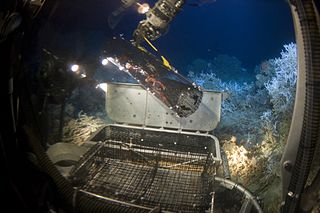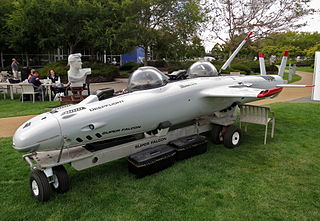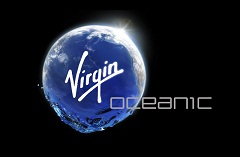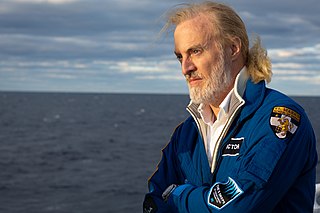Related Research Articles

The Challenger Deep is the deepest-known point of the seabed of Earth, with a depth of 10,902–10,929 m (35,768–35,856 ft) by direct measurement from deep-diving submersibles, remotely operated underwater vehicles and benthic landers, and (sometimes) slightly more by sonar bathymetry.

The Mariana Trench or Marianas Trench is located in the western Pacific Ocean about 200 kilometres (124 mi) east of the Mariana Islands; it is the deepest oceanic trench on Earth. It is crescent-shaped and measures about 2,550 km (1,580 mi) in length and 69 km (43 mi) in width. The maximum known depth is 10,984 ± 25 metres at the southern end of a small slot-shaped valley in its floor known as the Challenger Deep. However, some unrepeated measurements place the deepest portion at 11,034 metres (36,201 ft). If Mount Everest were hypothetically placed into the trench at this point, its peak would still be underwater by more than 2 kilometres (1.2 mi).

A bathyscaphe is a free-diving self-propelled deep-sea submersible, consisting of a crew cabin similar to a bathysphere, but suspended below a float rather than from a surface cable, as in the classic bathysphere design.

A submersible is a small watercraft designed to operate underwater. The term submersible is often used to differentiate from other underwater vessels known as submarines, in that a submarine is a fully autonomous craft, capable of renewing its own power and breathing air, whereas a submersible is usually supported by a surface vessel, platform, shore team or sometimes a larger submarine. In common usage by the general public, however, the word submarine may be used to describe a craft that is by the technical definition actually a submersible. There are many types of submersibles, including both crewed and uncrewed craft, otherwise known as remotely operated vehicles or ROVs. Submersibles have many uses worldwide, such as oceanography, underwater archaeology, ocean exploration, adventure, equipment maintenance and recovery, and underwater videography.

Don Walsh is an American oceanographer, explorer and marine policy specialist. He and Jacques Piccard were aboard the bathyscaphe Trieste when it made a record maximum descent into the Challenger Deep on January 23, 1960, the deepest point of the world's oceans. The depth was measured at 35,813 feet (10,916 m), but later and more accurate measurements have measured it at 35,798 feet (10,911 m).

A deep-submergence vehicle (DSV) is a deep-diving crewed submersible that is self-propelled. Several navies operate vehicles that can be accurately described as DSVs. DSVs are commonly divided into two types: research DSVs, which are used for exploration and surveying, and DSRVs, which can be used for rescuing the crew of a sunken navy submarine, clandestine (espionage) missions, or both. DSRVs are equipped with docking chambers to allow personnel ingress and egress via a manhole.

Kaikō was a remotely operated underwater vehicle (ROV) built by the Japan Agency for Marine-Earth Science and Technology (JAMSTEC) for exploration of the deep sea. Kaikō was the second of only five vessels ever to reach the bottom of the Challenger Deep, as of 2019. Between 1995 and 2003, this 10.6 ton unmanned submersible conducted more than 250 dives, collecting 350 biological species, some of which could prove to be useful in medical and industrial applications. On 29 May 2003, Kaikō was lost at sea off the coast of Shikoku Island during Typhoon Chan-Hom, when a secondary cable connecting it to its launcher at the ocean surface broke.

Mir were a self-propelled class of deep-submergence vehicle. The project was initially developed by the USSR Academy of Sciences along with Design Bureau Lazurith. Later two vehicles were ordered from Finland. The Mir-1 and Mir-2, delivered in 1987, were designed and built by the Finnish company Rauma-Repola's Oceanics subsidiary. The project was carried out under the supervision of constructors and engineers of the Shirshov Institute of Oceanology.

Deep-sea exploration is the investigation of physical, chemical, and biological conditions on the sea bed, for scientific or commercial purposes. Deep-sea exploration is considered a relatively recent human activity compared to the other areas of geophysical research, as the depths of the sea have been investigated only during comparatively recent years. The ocean depths still remain a largely unexplored part of the planet, and form a relatively undiscovered domain.

The DeepFlight Super Falcon is a personal submarine designed by Graham Hawkes, a former civilian ocean engineer. It was hoped that the technology used in this submersible would allow travel to the deepest parts of the ocean.

Virgin Oceanic is an undersea leisure venture of Newport Beach, CA businessman Chris Welsh and Sir Richard Branson, part of Sir Richard Branson's Virgin Group. The brand was first reported in a 2009 Time Magazine interview. The flagship service provided by Virgin Oceanic was intended to take visitors to the deepest parts of the ocean; however, as of late 2014, the project has been put on hold until more suitable technologies are developed.
The Necker Nymph is a submersible vehicle operated by Virgin Aquatic from the 32-metre yacht Necker Belle, which is based at the Virgin Limited Edition resort Necker Island in the British Virgin Islands.
DeepFlight Merlin is a personal submarine by Hawkes Ocean Technologies, part of the DeepFlight line of submersibles. The positively buoyant submersible was designed by Graham Hawkes. The Merlin was the first winged open-cockpit submarine available on the market, and first three-man submarine in the "aero submarine" class, representing a major advance in scuba diving technology.
Hawkes Ocean Technologies is a marine engineering firm that specializes in consumer submarines, founded by Graham Hawkes. It is headquartered in San Francisco, US.

The bathyscaphe Archimède is a deep diving research submersible of the French Navy. It used 42,000 US gallons (160,000 l) of hexane as the gasoline buoyancy of its float. It was designed by Pierre Willm and Georges Houot. In 1964, Archimède descended into "what was then thought to be the deepest part of the Puerto Rico Trench", which the NY Times reported as 27,500 feet (8,400 m). On 21 December 2018, a dive by Victor Vescovo in the DSV Limiting Factor found the "true bottom" of the Atlantic Ocean to be 27,480 feet (8,380 m), in the first manned descent to the deepest "verified bottom" of the Atlantic Ocean.

Graham Hawkes is a London-born marine engineer and submarine designer. Through the 1980s and 1990s, Hawkes designed 70% of the manned submersibles produced in those two decades. As late as 2007, he held the world solo dive record of 910 metres (2,990 ft) in the submarine Deep Rover.

Jiaolong is a Chinese crewed deep-sea research submersible that can dive to a depth of over 7,000 metres (23,000 ft). It has the second-greatest depth range of any crewed research vehicle in the world; the only crewed expeditions to have gone deeper were the dives of the Trieste bathyscaphe in 1960, Archimède in 1962, Deepsea Challenger in 2012, and DSV Limiting Factor in 2019.

Deepsea Challenger is a 7.3-metre (24 ft) deep-diving submersible designed to reach the bottom of Challenger Deep, the deepest-known point on Earth. On 26 March 2012, Canadian film director James Cameron piloted the craft to accomplish this goal in the second crewed dive reaching the Challenger Deep. Built in Sydney, Australia by the research and design company Acheron Project Pty Ltd, Deepsea Challenger includes scientific sampling equipment and high-definition 3-D cameras; it reached the ocean's deepest point after two hours and 36 minutes of descent from the surface.
DeepFlight Challenger is a one-person personal submarine deep submergence vehicle with full ocean depth capability. It is an "aero-submarine" which uses hydrodynamic forces to descend, as the sub has positive buoyancy, utilizing DeepFlight technology from Hawkes Ocean Technologies. The submarine is currently owned by Virgin Oceanic.

Victor Lance Vescovo is an American private equity investor, retired naval officer, space tourist and undersea explorer. He is a co-founder and managing partner of private equity company Insight Equity Holdings. Vescovo achieved the Explorers Grand Slam by reaching the North and South Poles and climbing the Seven Summits, and he then visited the deepest points of all Earth's five oceans during the Five Deeps Expedition of 2018–2019.
References
- 1 2 Springer, Bill (2018-08-31). "Richard Branson To Join Personal Submarine Expedition To The Bottom Of The Blue Hole In Belize". Forbes. Retrieved 2019-05-27.
- ↑ newsdesk, iHLS (2019-05-09). "Navy to 3D Print Personal Submarines for SEALs". iHLS. Retrieved 2019-05-27.
- 1 2 New York Times, "SCIENTIST AT WORK: Graham Hawkes; Racing to the Bottom Of the Deep, Black Sea", William J. Broad, 1993 August 3
- ↑ CNBC Magazine, "Deep Water's New Horizon" Archived 2011-09-08 at the Wayback Machine , September 2010
- ↑ Gizmag, "James Cameron performs deepest-ever solo sub dive, with a deeper one on the way", Randolph Jonsson, 11 March 2012
- ↑ Gizmag, "James Cameron snags world record for deepest possible solo dive", Randolph Jonsson, 25 March 2012
- ↑ Burnaby Mail, "Her Deepness drops in and warns of growing threat to the oceans", Deborah Smith, 2011 November 23